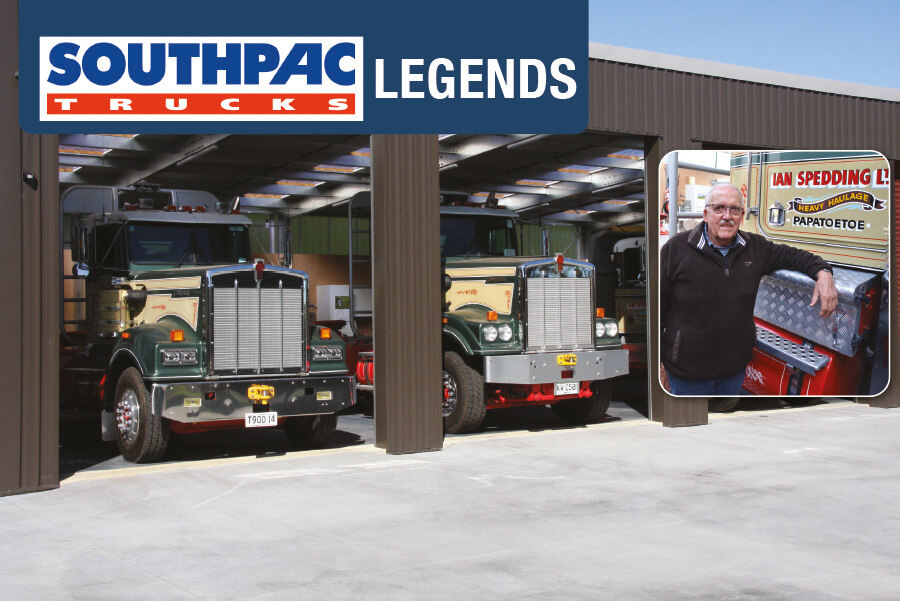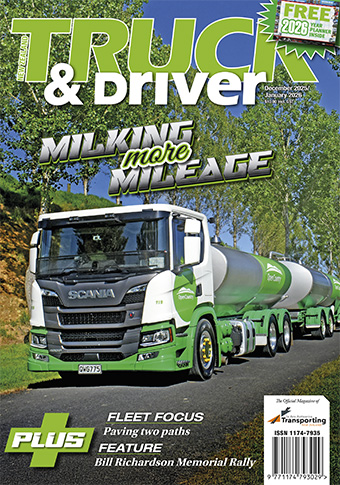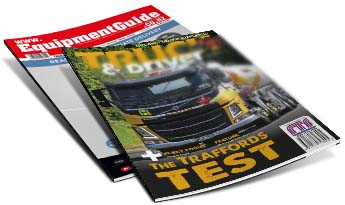Southpac Legends


Ian Spedding
Southpac Legends
FOR WELL OVER FIFTY YEARS, IAN SPEDDING AND HIS namesake business ‘Ian Spedding Transport’ has shifted copious amounts of kiwi dirt and earth in order to shape the modern day Auckland City that we see today. However, it’s this ‘hobbyists’ unwavering passion for keeping his trucks and gear in pristine condition that makes him a Southpac legend.
Originally from the motherland, the now octogenarian Ian arrived on NZ shores at the age of 11.
“My parents [Mary and Harry] came out from England in 1951. They bought a house in Otahuhu, and I lived there until I got married at 29.”
Ian can trace his love of trucks back to his childhood, saying that he had “a thousand Dinky toys’ when he was a kid.”
However, he is quick to add that even from an early age he was keen on machinery and was very mechanically minded.
...FOR WELL OVER FIFTY YEARS, IAN SPEDDING AND HIS namesake business ‘Ian Spedding Transport’ has shifted copious amounts of kiwi dirt and earth in order to shape the modern day Auckland City that we see today. However, it’s this ‘hobbyists’ unwavering passion for keeping his trucks and gear in pristine condition that makes him a Southpac legend.
Originally from the motherland, the now octogenarian Ian arrived on NZ shores at the age of 11.
“My parents [Mary and Harry] came out from England in 1951. They bought a house in Otahuhu, and I lived there until I got married at 29.”
Ian can trace his love of trucks back to his childhood, saying that he had “a thousand Dinky toys’ when he was a kid.”
However, he is quick to add that even from an early age he was keen on machinery and was very mechanically minded.
“I used to go and mooch around the bus company and one of the mechanics there decided that he and a mate were going to buy a service station and when they did, they took me on as an apprentice mechanic.”
He recalls that the motor apprenticeship turned into a diesel apprenticeship and his engineering career grew from there.
“I went to Otahuhu Welding and then Bitumix and then went to Eddie Seay of E. Seay Limited. That was great, I enjoyed that.”
Ian says that when he started work for Eddie Seay, it was initially just driving. But since Eddie had a fleet of trucks, he also ran the workshop for him.
“We built a big 10 bay workshop in Lovegrove Crescent Otara, and that’s the one I just sold,” Ian says.
In 1970, Ian decided to go out on his own. He bought a truck and a licence and began carting rocks from the quarry.
“I bought a licence off Morrie Selwyn for $500 in 1971. And that licence has a phosphate number with it which made you eligible for work every time a ship came in. It was gold for someone like me starting off as we got paid at the end of every boat load.”
Spedding started off in business with a 7-tonne Commer and did a fair amount of work for Papatoetoe Borough Council, so was “up and away real early.”
However, the Commer was soon to be moved on and upgraded.
“I sold the Comer for a 1418 Merc because the traffic cops in Auckland city used to give you a smoke fine, basically anything that smoked they’d give you a ticket, they were really hot on it - nothing came out of the Merc.”
Ian says the business grew from there. He recalls that he was mainly doing phosphate and quarry work, but soon got a tap on the shoulder to expand.
“I just worked away quietly. Winstone’s came to me and asked if I’d put another truck on, which I did. I put on a blue and white Kenworth which was their colours of the day. It was a brand new W923 and in 1973 cost me $38,400 (Ian still has the sales slip).”
With the addition of the new truck, Spedding also put on his first driver and together they moved quarry rock, bulk haulage around Auckland.
The next year Spedding added another Kenworth to the fleet, a 1975 W924 and then another driver.
“It was built in Canada in ‘75 and went on the road in ‘76. And then a year later I bought another one, so I had three Kenworth’s.”
As the end of the `70s neared, Spedding expanded his loads and finished up doing grain, doing work for Jimmy Frankham.
“We were able to run through to about 1979 when Auckland just came to a halt. Auckland stopped construction, they did the Grafton gully, and they didn’t think they needed to do anything else. It was terrible actually. Winstone’s just said `sorry we can’t give you any more work’, it was quite depressing.”
Despite the huge drop in workloads, Spedding kept the two drivers on, but says that around the late 70s to early 80s, it was very hard times for the business. But better times lay ahead.
“In 1980 we got the Hardies job, and it was in partnership with Garth Thompson. Garth and I did the job and then later on I bought his share out.”
Ian says that concentrating on efficiency, they only ran about six or seven trucks, shifting tens of thousands of tonnes of silica sand every year for the next 15-20 years for James Hardie.
“We mined the sand for a start and carted it down to Kumeu to be washed. And carted it down to Auckland. And the waste product went from Kumeu back to the sandpit. It was a huge part of what we did.”
Things ticked along, then in 1988 Ian was approached to move pumice out of the Waikato River from Mercer to a factory in Penrose. And on top of that, moved the gypsum off the wharf. However, things were about to take a downturn again.
“I bought a T600 to do the pumice job and in ‘91 they gave us three months’ notice and said, ‘mate there’s no more pumice’. So, times were bloody tough again. Really tough then, that was after the share market crash. So, I didn’t know what I was going to do, and we had just bought a house.”
Ian recalls that he was talking to a few people about the troubles and that Brice from PGF gave him a call offering to purchase the T600.
“That eased the pain quite considerably.”
Reluctantly Spedding had to lay off the driver too but says that he got him a job right next door.
That same year Ian reckons that he made one of his best decisions, buying the Lovegrove workshop he was renting.
“Best thing I did, it was amazing. It was hard at the time as I was paying rent there, Eddie had moved on and gone. The guys that owned it fell over because of the share market and it was going to be a mortgagee sale.
“I was there one Saturday morning, and a land agent came in to have a look at it. I was kind of the caretaker, and he told me what was happening. So, I put an offer in and he rang me a couple of days later and said `put your offer up $10,000 and it’s yours.’
“He said `you’ve only got a minute to tell me, yes or no’. I said `alright, I’ll take it’.”
Spedding says that he had 24 hours to sort it all out and that his bank was “absolutely rubbish, hopeless.”
Thankfully UDC came to his rescue. “I owe it to them.”
Ian bought the workshop and the business progressed from there. He bought a T900 in `94 as he was doing a lot of work for Atlas Concrete at that time and then in 2007 bought the first 604.
“I finished up with 10 Kenworth’s at the peak. We’ve had good work all along, but I’ve never wanted big numbers of trucks in the fleet. We could have gone for more trucks easily, but I was comfortable with what we had.”
When Hardies called time on their workload, Spedding decided to rethink his own position.
“I thought, `well I’m running out of birthdays, I’d better do something about the business.”
Ian says that they finished up on Labour Day last year.
“I walked out of the yard and locked the gate for the last time. It was a Saturday, quarter to one. My time was 51 years, but I’d been in the depot since `68. Alan Lang took over the trucks on the first of August. I just wanted to make sure that the place worked. It’s very successful for them, they’ve got a good business there. Unfortunately, they didn’t have Hardies.”
He says that selling the business was extremely hard, as transport is a six and a half day a week job when you’re employing people.
“I had a really good team of drivers, dedicated guys, and that’s important. I was fortunate enough to have a really top service manager in Jono Hirst who was with me for 18 years and also Shane Buchanan who was with me for 34 years and looked after the James Hardie contract.”
But it would appear Ian wasn’t ready to hang up his tool belt just yet. In fact, selling his business means he can now concentrate on his other passion - rebuilding trucks from the ground up from his three-garage workshop at home.
The 4-bay custom-build workshop is a sight to behold, with a kitchen and toilet.
“I wasn’t allowed to put a shower in. Joy [Ian’s wife] said `I’d better come home’.”
Three `long-nose’ Kenworth’s take pride of place inside, each having been carefully rebuilt by Ian.
“I’ve been blessed with good jobs for my trucks, and the trucks were a piece of cake to run so I had a lot of time to do what I wanted to do.”
And what he wanted to do was meticulously bring trucks back from the brink of the scrapyard.
He says that when he bought one of the trio, the transporter, it was in a terrible state, and it took him two years to bring it back to pristine condition.
“I’m just mechanically minded and that’s what I like doing. I like Kenworth’s and they’ve been good to me. I’m an enthusiast - other people own race cars,” he says.
Sitting outside the workshop is another new project, an ex-Rotorua NZFP Kenworth L923. It’s already stripped right back to the chassis rails.
“I’ll be trying to make a silk purse out of a sow’s ear. It’ll take me a couple of years.”
Ian does all the work inhouse, apart from the cab which goes to Willie Malcolm in Rotorua and the painting. But he does have a few pals that are happy to lend a hand.
“Ken Frandy, Don McLean from Freightways, Glassy and Graeme Payne come in and help out - there’s lots of tea drunk here.”
Ian has fond memories of the business and believes that despite being hard work, it’s given him a good life, with annual six-week holidays thrown in for good measure.
“We weren’t big, just small, and efficient and we had good gear. Joy has put up with a lot and my daughter Kay was running the office.”
But Ian is happily embracing his ‘retirement’.
“The secret to retirement is being occupied. I’m fortunate, I’m reasonably healthy. I haven’t missed it and I’m so pleased that it’s gone well for Alan and Jono.
“I’m proud of that fact. I would have hated to have sold them a pup.”



 + EQUIPMENT GUIDE - FREE
+ EQUIPMENT GUIDE - FREE
